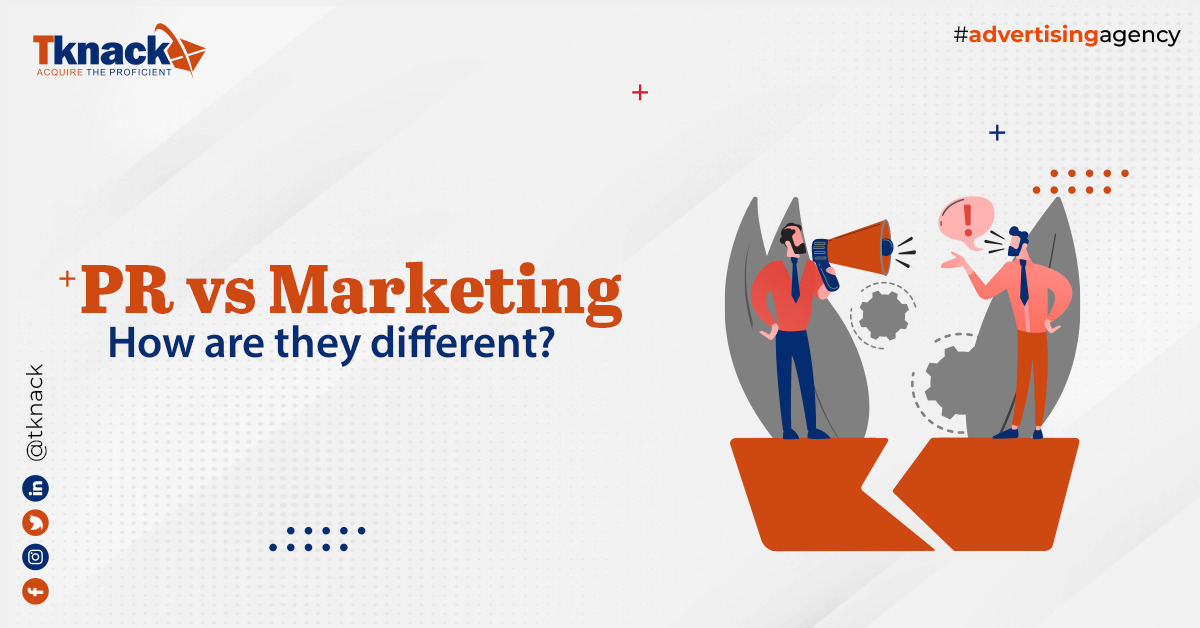PR vs marketing: how are they different?
In the fast-changing world of business and communication, Public Relations (PR) vs Marketing are two different things but interconnected pillars that organizations utilize to reach multiple objectives.
Although both aim to promote brands and boost organizational success, they operate on different principles, employing distinct strategies and tactics.
Public Relations, at its core, revolves around cultivating relationships, managing reputations, and fostering a positive image within a broad spectrum of stakeholders.
On the other hand, Marketing is inherently focused on driving sales, creating brand awareness, and generating revenue through targeted campaigns and promotional activities.
One can understand how these strategic approaches impact organizational communication and success by examining the differences between PR and marketing.
What are public relations (PR)?
Public Relations, often abbreviated as PR, is a continuous and long-term process to cultivate and sustain positive relationships between a company and its immediate environments, including customers, employees, investors, and the media.
This strategic approach to communication focuses on shaping a favorable image over an extended period. Crucially, PR activities must align seamlessly with the company’s overarching goals, necessitating ongoing evaluation and refinement.

YPES OF Public Relations (PR)
Public relations are diverse in its various types, each with its distinct focus and tactics. These are some of the common ones:
- Media Relations: It is essential to establish and maintain connections with journalists and other media professionals to ensure positive coverage of the company and its initiatives.
- Internal Communications: Fostering open and transparent communication with employees to keep them informed, engaged, and aligned with the company’s goals and values. It includes employee newsletters, town hall meetings, and internal social media platforms.
- Crisis Communications: Preparing for and managing negative publicity or events that could damage the company’s reputation. It requires quick thinking, clear messaging, and effective stakeholder communication.
- Community Relations: Building positive relationships with the local community where the company operates. It can involve sponsoring events, volunteering programs, and partnering with local organizations.
- Public Affairs: Influencing public policy and legislation that could impact the company’s business. It involves lobbying, building relationships with government officials, and educating the public about the company’s position on critical issues.
- Online and Social Media Communications: Engaging with audiences through online channels and social media platforms is crucial to building brand awareness and managing the company’s online reputation. It can involve creating content, responding to comments, and running social media campaigns.
- Investor Relations: Building and maintaining relationships with investors and analysts to ensure they clearly understand the company’s financial performance and prospects. It involves producing investor materials, holding earnings calls, and meeting with investors individually.
The specific kind of PR a company needs will depend on its industry, size, target audience, and specific goals.
ADDITIONAL TYPES OF PR
In addition to the types of PR listed above, there are also numerous specialized PR practices, such as:
- Digital PR: Using digital channels to generate positive online coverage and engagement.
- Product PR: Securing positive coverage of new products and services.
- Healthcare PR: Communicating effectively with patients, healthcare professionals, and the public about healthcare-related issues.
- Non-profit PR: Raising awareness and support for non-profit organizations.
PR activities can be conducted by either in-house PR specialists or an outside PR agency.
What is Marketing?
Marketing attracts interest in buying or selling products or services by conducting market research, analysis, and advertising.
This process entails generating, conveying, delivering, and exchanging offerings that hold value for customers, clients, partners, and society.
Marketing is a field that is constantly evolving and encompasses a diverse range of strategies and tactics to promote products, services, or ideas to generate sales and foster customer loyalty.
Whether you are an in-house marketer or a marketing agency, marketing activities can be carried out based on the 4P principle of product, price, a place to sell your product, and promotion.
PR vs marketing: how are they different?

Types of Marketing
Leverages digital avenues such as websites, social media platforms, email communication, search engines, and online advertising Strategies that effectively reach and engage the intended audience.
Creating and sharing relevant articles, videos, podcasts, and other media is the primary method of content marketing to attract, engage, and maintain an audience.
Social Media Marketing (SMM) is a marketing strategy that targets social platforms like Facebook, Instagram, and TikTok to promote brands, grow target audiences, drive website traffic, and increase sales.
They work with influencers or people with a large online following to advertise products or services to their audience.
Event Marketing:
Involves organizing or participating in events like trade shows, conferences, and product launches to promote products and engage with potential customers.
Similarities between PR and Marketing
While Public Relations (PR) vs Marketing are distinct fields with unique goals and strategies, they share some commonalities in their overall objectives and functions. Here are some key similarities:
Communication:
In PR vs marketing, Both PR marketing involves communication strategies to convey messages to specific audiences. They aim to influence perceptions, build relationships, and create awareness.
Audience-Centric Approach:
PR vs Marketing both focus on understanding and connecting with their target audiences. Whether it’s building relationships in PR or identifying customer segments in Marketing, both emphasize meeting the needs and expectations of their respective audiences.
Brand Management:
PR vs Marketing contributes to brand management. Where PR focuses on overall reputation, building trust, and managing the public image, Marketing contributes to brand identity, promotion, and differentiation in the marketplace.
Media Utilization:
Certainly, in PR vs marketing PR often involves media relations, and Marketing frequently utilizes various media channels for advertising and promotions. Both fields recognize the importance of leveraging media to reach and influence their target audiences.
Relationship Building:
Both PR vs marketing involve relationship-building, albeit with different focuses. Where PR concentrates on fostering relationships with various stakeholders, Marketing aims to build relationships with customers and clients to drive sales and loyalty.
Strategic Planning:
In PR vs marketing, both disciplines require strategic planning. PR develops strategies for reputation management, crisis communication, and stakeholder engagement, while Marketing develops plans for product promotion, customer acquisition, and revenue generation.
Market Research:
In PR vs marketing, both PR marketing benefits from a solid understanding of the market. Market research is vital for identifying trends and comprehending
consumer behavior, and making informed decisions in both fields.
Goal Alignment:
Ultimately, the goals of PR vs Marketing are aligned with overall organizational objectives. Both contribute to the success and growth of the organization, albeit through different means.
KEY DIFFERENCES BETWEEN PR VS MARKETING
Organizations must grasp these distinctions to efficiently utilize PR vs Marketing in a comprehensive communication and promotion strategy.
Definition and Focus:
- Public Relations (PR): Maintaining positive relationships and managing information flow between the company and society.
- Marketing: Comprises multiple activities focused on producing, communicating, and delivering valuable customer products and services.
Promotion Aspect:
- Public Relations (PR): Focuses on promoting the organization and its brand.
- Marketing: Concentrates on promoting specific products and services offered by the company.
Nature in Management Function:
- Public Relations (PR): The staff function is considered to aid the organization in indirectly achieving its objectives.
- Marketing: Regarded as a line function directly impacting the company’s bottom line.
Media Utilization:
- Public Relations (PR): Relies on earned media, gaining publicity through third-party endorsements.
- Marketing: Paid media is the foundation, and channels like radio, television, and print advertising are utilized.
Target Audience:
- Public Relations (PR): Public relations aims to appeal to a vast and multidimensional group of individuals, including your stakeholders, customers, employees, and the media, as well as the general populace.
- Marketing: The marketing audience is the one who makes a purchasing decision, which may include both current and prospective customers, whether they are business-to-business (B2B) or business-to-consumer (B2C) audiences.
Objective:
- Public Relations (PR): Aima at building trust and maintaining the company’s reputation.
- Marketing: Aim at converting shoppers into buyers, focusing on creating sales.
Communication Nature:
- Public Relations (PR): The characteristic of this communication is two-way, which promotes dialogue and engagement.
- Marketing: Primarily a monologue activity involving one-way communication directed at the audience.
Success Metrics:
- Public Relations (PR): Measuring success in public relations involves generating buzz, gaining positive media exposure, bringing positive change to your brand perception, winning awards at industry events, and more.
- MARKETING: In marketing, success is defined by figures, such as increased online traffic for a particular product or service and growth of followers on social media.
Influence Scope:
- Public Relations(PR): PR employs power to alter the perception through reputation management
- Marketing: Marketing leverages power to impact buyer behavior by addressing their needs.
Return On Investment (ROI):
- Public Relations (PR): Measurement is difficult when measuring the ROI in public relations, which results from increased credibility and trust.
- Marketing: The return on investment in marketing is measured by the number of new customers and sales generated.
Legitimacy Of Messages:
Media and bloggers deliver PR messages, which consumers recognize as more legitimate and earned exposure, as opposed to the commonality of paid marketing messages.
Advertisement vs PR public relations
Advertising and public relations (PR) are two distinct but closely related communication disciplines organizations use to promote their products, services, or brand image. While both aim to enhance the reputation and visibility of a business, they differ in their approach, purpose, and methods.

Advertising vs Marketing
Marketing is the strategic approach to comprehending and fulfilling customer needs, which involves various activities, including researching the market, developing products, and managing customer relationships. It consists of crafting a comprehensive plan to connect products or services with the target audience effectively.
On the other hand, while integral to marketing, advertising is a more focused tactic that utilizes paid channels to communicate messages and promote brand visibility. It is a powerful tool within the marketing toolkit, contributing to creating awareness and driving consumer actions.
Therefore, marketing orchestrates a holistic customer-centric strategy, whereas advertising is a specific means to achieve visibility and engagement in the market.

Comparisons and differences between PR vs Marketing vs Advertising
Although there are differences, successful marketing strategies still depend on the unique characteristics of each discipline. An integrated approach that blends elements of PR vs Marketing and Advertising vs marketing and advertising vs PR is employed to achieve comprehensive communication and promotional goals.
Features | Public Relations (PR) | Marketing | Advertising |
Objective | Develop and sustain positive relationships; manage reputation | Promote products, generate revenue, and drive sales. | Use paid messages to increase awareness and change behavior. |
Audience Focus | The broad audience consists of media, stakeholders, and the public. | Targeted audience, specific customer segments | The general or specific audience, depending on the campaign |
Channels | Community engagement, media relations, and events. | Advertising, social media, content marketing | Print, TV, radio, online, billboards, etc. |
Credibility | Emphasizes building credibility and trust; relies on third-party endorsements | More controlled messaging may be viewed as promotional | Relies on creative messaging and visual impact |
Timeframe | Focuses on long-term relationship-building and reputation management | Often short-term, with campaigns and promotions aimed at specific goals | Campaign-based, can be short or long-term |
Metrics | Reputation, media coverage, stakeholder engagement | Sales figures, conversion rates, ROI, campaign performance | Reach, impressions, click-through rates, conversion rates |
Type of Messages | Storytelling, narrative-building, relationship-building | Promotional, product-focused, value proposition | Attention-grabbing, persuasive, call-to-action |
Function Focus | Relationship management, reputation building, crisis communication | Product promotion, sales, customer engagement | Creating awareness, influencing behavior |
Control over Message | Less control due to reliance on earned media and third-party opinions | More control over messaging and promotional content | High-control, messages are crafted by advertisers |
Tools and Tactics | Press releases, media interviews, events, community outreach | Advertising, social media campaigns, email marketing, promotions | Print and digital ads, TV and radio commercials, online banners |
Time Sensitivity | Often ongoing and focused on long-term impact | Can be time-sensitive, with campaigns having specific durations | Campaign-specific, with defined start and end dates |
Budget Allocation | Often more focused on relationship-building and may have a smaller budget | Allocated budget for promotional activities and campaigns | Requires a significant budget for media placement and production |
Example Scenario | Crisis management, community engagement, positive media coverage | Product launch, market research, customer acquisition | New product promotion, brand awareness campaign |

CONCLUSION
In conclusion, to achieve the best results possible, combining PR vs marketing efforts is necessary because people are emotional beings. The comparison between Public Relations (PR) vs marketing reveals distinct yet interconnected facets of organizational communication. While PR focuses on cultivating positive relationships and managing reputation, marketing aims to drive sales and promote specific products or services. Both disciplines are instrumental in shaping an organization’s image and achieving strategic objectives.




